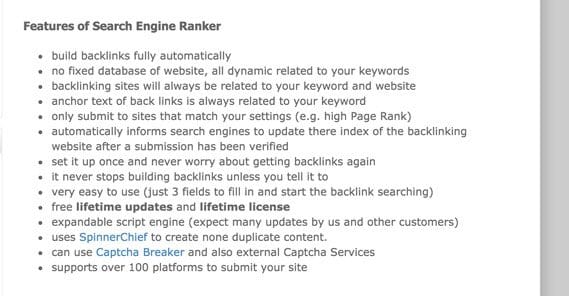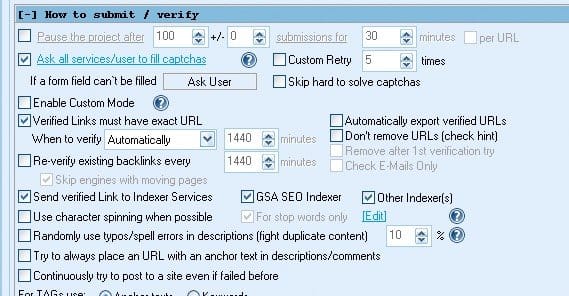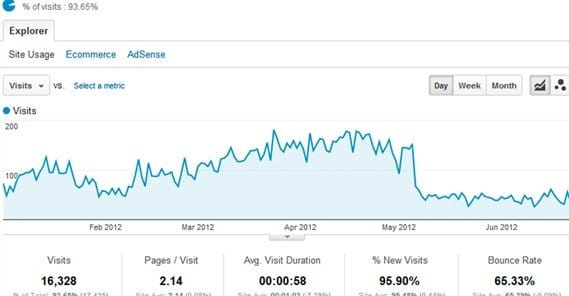Our Honest GSA Search Engine Ranker Review

GSA Search Engine Ranker is a piece of software that automates a lot of what you need for marketing in today’s Internet. There’s a lot to it, but like all gray and black hat applications, there’s a ton of misinformation out there.
I want to say this right up front. GSA is a black hat tool, which means using it is very risky. It can work – all black hat techniques work – but it can also be abused and ruin you. This is the problem with black hat techniques in general. They will work, but only for a limited time. After that time is over, your site is likely going to be penalized or deindexed, and you will have to spend the time fixing the damage before you move on to other strategies to grow again.
This, to me, is the fundamental difference between black hat and white hat tools and techniques. Black hat techniques have a “growth curve” that looks like a sine wave. You have peaks where the technique is working, and you have valleys where it’s caught out and penalized. Meanwhile an organic white hat growth curve is more standard slow incline, with some jitters as you experiment with different techniques.
The Problem of Trust
Why should you trust this review? Why should you trust me? Well, for one thing, I’m not trying to sell you the software. I’m not going to give you a referral link, and I’m not going to sell you a service that uses GSA, like a lot of Fiverr link building gigs.
This is the problem you will encounter if you run some searches for GSA reviews online.
There are a lot of highly ranked sites pushing reviews that target newbie SEOs and marketers. Just look at the first few paragraphs of this article. It’s the exact same kind of language every salesperson shilling Cutco knives or Britannica encyclopedias uses when they go door to door.
The problem is, this is suspicious language meant to shill a product while minimizing the amount of legitimate truth pushed in the review. You’ll note that none of these reviews will tell you about the risks of using the software, nor will they tell you that Google will flag your use of GSA as spam if you use it poorly.
Plus, this is a unique situation here, because these reviews are all talking about GSA, which is a piece of software designed to rank a website. It wouldn’t be hard to rank a site for a review of that application using it, and then sell it via referral. Of course, then any lies about it working wouldn’t be lies, because it worked enough to get the review ranked. It’s a bit of a catch-22. Do you trust it because it’s ranked and thus that ranking probably was assisted by the software, or do you not trust it because it’s using disingenuous language to shill a product without providing all of the information?
That issue is at the core of why I decided to investigate and write an honest review of GSA Search Engine Ranker.
What It Is, What It Does
GSA is a piece of software, that much has been established. It’s a marketing tool, meaning it’s designed to help you take a website and make it more popular by making it rank higher in Google’s web search. I’ve also established that it’s a black hat application, but I haven’t mentioned why. Let’s get into that here.
GSA is a program that abuses one part of Google’s ranking algorithm. Namely, it abuses backlinks. If you’re familiar at all with black hat SEO, you’re already getting some idea of the problems here.
So, Google has an algorithm that it uses to determine how relevant a site is to a particular keyword, and how valuable the content on that page is. This double calculation is done for every post for every keyword it could possibly be relevant for. Moz.com, for example, is going to be very highly rated for SEO guide keywords, but if you tried to find it in the search results for chocolate cookie recipes, you wouldn’t be able to. That doesn’t mean Moz is a bad site; it just means Moz doesn’t suit your needs when you want to bake.
Part of the algorithm is an analysis of content. Google scans your content and looks for various attributes it may or may not possess. It looks for keywords to identify what sort of topics your content will cover. It looks for linguistic signs that help tell whether or not the content is real or if it’s gibberish. It looks for uniqueness, comparing the data in the post to data in the index to see if the post was copied from some other location. It will even do basic content synonym swaps to check to see if the content was spun, though spinning algorithms in modern software tend to be more robust than what Google can easily detect.
Another part of the algorithm checks links. It looks for links on your site to other parts of your site. It looks for links on other sites pointing to your site, and checks to see if those sites are related to the topic of your site, and if the links make sense in their position and context. It looks for links on your site pointing to other sites, again checking to see if they’re contextually relevant and potentially valuable.
More parts of the algorithm look up other aspects of your site to figure out where to rank it. You can read this post on Backlinko to get an idea of what it looks at, though there’s no guarantee that the list in that post is actually the real list. Google, for good reason, doesn’t actually publish the list or its algorithm.
GSA is a piece of software that automates link building. That is, it creates links that point to your site. Those links, if they’re beneficial, relevant links, will benefit your site; that’s how Google works. How does GSA go about it?
The first thing GSA does is includes a massive list of websites in a huge number of niches, to cover pretty much any possible topic. This database is being kept up to date by the makers of GSA. It is categorized by method, rather than topic. So when you tell GSA where to submit your links, you’re choosing from categories like article, blog comment, exploit, web forum, WordPress pingback, RSS feed, social network, and wiki.
If you run a blog on WordPress, you might have a few spam comments to moderate and a handful of pingbacks from sites you’ve never heard of. These are the sorts of links that GSA creates. Spam comments created by GSA often look almost natural, but don’t really provide any value. They’re the sort of “thanks for sharing this post, it’s full of great information” comments that lack all specifics and seem fine right up until you see that some random website is linked in the user profile section of the comment.
Sure, in most cases – like comments, Pingbacks, or wikis – these links are going to be nofollowed. That doesn’t matter too much to GSA, though, or to Google. Nofollowed links are still links, and they’re still implied mentions even if they aren’t supposed to count as valuable links.
For other sites, like article directories, forum posts, and articles, GSA needs some supplemental content. No one cares about a link that isn’t attached to content, right? A blog that posts a single link as an entry isn’t a good blog. That’s why GSA includes an article spinner. You plug in an article or two, and GSA will apply various spinning filters to change the content. The meaning of the content ostensibly won’t change, but the actual wording will be unique enough that Google won’t flag the two as copied. You can see some examples of spinning in this post.
There are a lot of problems with spun content. No piece of software exists to create fluent-sounding content, even with a seed. By swapping out synonyms, you change the meaning of a sentence. The words “body” and “corpse” exist as synonyms for a dead person, but the phrase “body of work” is a viable phrase, while the phrase “corpse of work” is not. That’s an extreme example, but it’s the sort of issue you get when you spin content.
Worse, you can’t just do a mild spin on content, changing a few minor details and hoping it passes. The less extreme the spin, the more likely Google will detect it as spun, because you can bet they reverse-engineer spinning apps and use that information to identify when content has been spun. That’s why it’s a constant arms race between black hat SEOs and Google.
Another red flag in GSA comes when you look at the options. You can blacklist domains like .edu and .gov for submission. You can blacklist sites that use Akismet. You can blacklist sites with too many outgoing links already. You can blacklist sites that add nofollow to their links. You can blacklist sites where your link has been posted before.
Are these signs of a high quality site, or are they signs of a spam engine? Why else would you want to tell the software to ignore sites running anti-spam measures? It’s all very spammy, and that’s a problem.
GSA also has other worrying spam features, like automatic account creation and captcha breaking. It virtually requires the use of web proxies on a rotating basis to keep from being blocked by major CMSs. It allows you to add a timer between link submissions to keep form triggering overflow protection bans. None of this is anything you need to worry about when you’re working with white hat tools.
What Isn’t Bad
All of that sounds awful, but if it was truly a scam piece of software, it wouldn’t have stuck around as long as it has. There are a lot of applications out there that charge you out the nose to buy it, and then charge you each time there’s an update, if you want to get the update to allow the software to keep working. This turns a one-time purchase into a glorified monthly fee. GSA, at least, doesn’t do that. The worst you might run into is someone trying to convince you to buy a site list for GSA. I doubt there’s really anything unique on that list, so buy it at your own risk.
GSA also tracks and keeps up with the links it submits. You will be able to see in real time how the links perform, whether they are removed or prevented from working for you, or if they’re still good. This is useful for analytics if you’re going to use GSA in a light, gray hat manner rather than full on black hat link spam (if such a thing even exists).
The Issue of Imbalance
Possibly the biggest problem I have with GSA is a subtle problem, and that’s the problem of metric balance. GSA does one thing and one thing only to build your SEO; submits links to sites around the web. This can earn you a ton of backlinks in a very short time, many of which may be legitimate or as close to legitimate as possible through automatic creation.
The problem comes when you look at that list of 200 search ranking factors I provided above. Google isn’t dumb. They take all of those factors and they consider them together. Yes, they look at your links, and yes, a lot of good incoming links makes for a beneficial influence on you. However, what happens if you have 10,000 incoming links, but only a few dozen blog posts, virtually no traffic, no organic brand mentions, and no social presence? Google gets a little skeptical about where those links are coming from.
It’s a lot like buying followers on Twitter; if you have 50,000 followers but no one ever retweets/likes your tweets, what good are those followers? They might allow you to steamroll other metrics to the fore, but they alone aren’t doing a lot for you.
GSA spikes one metric, albeit a beneficial one, in hopes of ranking your site quickly. You will – make no mistake – eventually be detected and have those good links turn bad. Some of them can be removed, but largely you will be left with the choice; abandon the site and start new on a fresh domain, or work to clean the backlink profile and start again with either an updated GSA or a different tool or technique.
Methods for Using GSA
There are essentially three methods you can use GSA for. One is gray hat, the other two are black hat.
The gray hat method is method 1, which is a combination of using white hat SEO and black hat tools. Do everything you need for a normal growth white hat site, and supplement it with a little, judicious use of GSA. This will automate some backlinks for you, but if you’re careful – limiting it to certain types of links and doing it slowly – those links look more organic. At that point, you’re just using it for a quick boost while your other methods kick in. In this way, it’s a lot like using PPC ads to supplement organic marketing.
The second method is turning GSA on to a narrow degree, but leaving it running. You’re going to build links constantly and get as much benefit out of them as you can before they start flipping into spam territory and penalizing your site. At this point, you need to disavow the links and find new targets. You can keep going with this cycle as long as you keep GSA and your sitelist up to date.
For both of these methods, you will be periodically disavowing links you created with GSA. I recommend keeping an exported list of the links you made, so you have an easy list to run through Google’s disavow tool.
The third method is firmly black hat. Make a site and turn GSA on it on full blast, options wide open. You should skyrocket through the ranks, but like a firework, you will burn out very quickly. When this happens, you just drop the site and start over. Ideally, in the month or so you have with the site in the rankings, you should be making a significant amount of money. This, of course, requires a great monetization scheme.
It’s up to you how you want to use GSA. Just remember; while it is a legitimate program that does as advertised and does it well, it’s still a black hat technique that will cause issues if you’re trying to live on the “right” side of the law.
 ContentPowered.com
ContentPowered.com










I really enjoyed reading this useful review..i was going to buy GSA but i’m worried..some told me to build tier 2 and tier 3 with GSA is useful to bring some link juice is it really useful??
is there any software that uses white hat techniques?